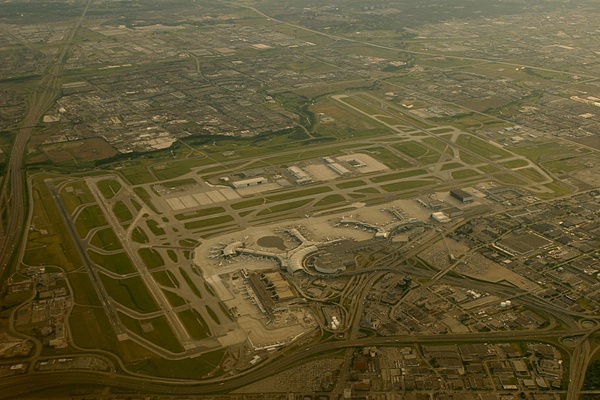Pearson Airport is physically located inside the city limits of Mississauga however it is commonly referred to as Toronto Pearson International Airport, also known as Lester B. Pearson International Airport. YYZ is the Airport Code.
Pearson International Airport currently has two operating terminals: Terminal 1 and Terminal 3.
Terminal 1 opened April 6, 2004. The old Terminal 1 was demolished to make room for additional gates at Pier E. Pier F at Terminal 1, which has an enlarged end called Hammerhead F, opened January 30, 2007, to replace Terminal 2.
 Pearson International Airport as seen from the air. Photo (cc nc sa) by Martin Cathrae.
Pearson International Airport as seen from the air. Photo (cc nc sa) by Martin Cathrae.
This pier accommodates for international traffic and adds 7 million passengers per year to the airport's total capacity. Redevelopment of the airport was a logistical challenge as the existing terminals remained operational throughout construction and demolition.
Fast Facts*
- Pearson International Airport is Canada’s busiest airport.
- In 2009, 30.4 million passengers traveled through Pearson and they handled 430,588 aircraft movements.
- An extensive list of scheduled and charter flights provide service to passenger in the Toronto region, flying non-stop and same plane service to more than 180 cities around the world.
Economic Development Statistics
- Jobs: 185,000 Taxes: 4.5 billion Output: 26.4 billion Income: 6.8 billion (Source: Taking Flight: The Airport Master Plan 2008–2030)
Cargo at Pearson
- In 2009, Pearson handled 431,939,879 metric tonnes of cargo.
- Pearson is home to 1.2 million square feet of warehouse space, an average of 0.42 tonnes per square foot.
- Pearson processes over 45% of Canada’s air cargo.
- Pearson is the only airport in Canada with scheduled freighter service to Europe, Asia, USA and Latin America.
Runways at Pearson
- Pearson has five main runways and 30 taxiways, constructed of concrete, asphalt or a combination of both
- Runway 06L-24R measures 2,895.6 x 60.9 metres (9,500 x 200 feet)
- Runway 06R-24L measures 2740.0 x 60.9 metres (9,040 x 200 feet)
- Runway 15L-33R measures 3,368 x 60.9 metres (11,050 x 200 feet)
- Runway 15R-33L measures 2,590.0 x 60.9 metres (8,500 x 200 feet)
- Runway 05-23 measures 3,389.2 x 60.9 metres (11,120 x 200 feet)
Key Agencies
| Organization | Key Functions |
| Greater Toronto Airports Authority | (GTAA) Management and operation of Toronto Pearson |
| Transport Canada | Responsible for federal air transportation policies and programs, development of laws governing airports and the airlineindustry. Transport Canada also manages the GTAA’s Ground Lease with the Federal Government. |
| Canadian Air Transport Security Authority (CATSA) | Reporting to the Minister of Transportation, Infrastructure and Communities, CATSA is the crown corporation that is responsible for preboard screening, operation and maintenance of explosive detection systems, and implementation of restricted area identification cards at Canadian airports. |
| Peel Regional Police | Peel Regional Police is under contract to the GTAA to provide police response and enforcement at the airport. |
| Canada Border Services Agency(CBSA) | CBSA is the federal government agency responsible for facilitating the free flow of persons and goods at the airport, such as customs, intelligence and enforcement, and inspection of imports. CBSA is also responsible for NEXUS Air and CANPASS Air. |
| Nav Canada | Nav Canada manages Canada’s air traffic control system |
| Citizenship and Immigration | Canada Facilitates the arrival of persons at the airport and their integration to Canada |
| U.S. Customs and Border Protection (CBP) | CBP manages the flow of persons and good at the airport, such as customs, intelligence and enforcement, and inspection of imports for flights destined for the United States. |
| U.S. Citizenship and Immigration Services (CIS) | US CIS is responsible for the administration of immigration and naturalization and establishment of immigration services at the airport |
| Transportation Safety Board (TBS) | TSB is the agency responsible for investigations of air transportation occurrences |
*Sources:
- Fast Facts from the GTAA website
- Wikipedia Article on Pearson http://en.wikipedia.org/wiki/Toronto_Pearson_International_Airport


